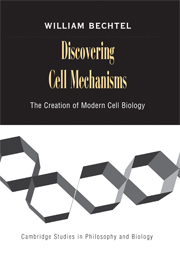Book contents
- Frontmatter
- Contents
- Preface
- 1 Introduction: Cell Mechanisms and Cell Biology
- 2 Explaining Cellular Phenomena through Mechanisms
- 3 The Locus of Cell Mechanisms: Terra Incognita between Cytology and Biochemistry
- 4 Creating New Instruments and Research Techniques for Discovering Cell Mechanisms
- 5 Entering the Terra Incognita between Biochemistry and Cytology: Putting New Research Tools to Work in the 1940s
- 6 New Knowledge: The Mechanisms of the Cytoplasm
- 7 Giving Cell Biology an Institutional Identity
- Afterword
- References
- Index
4 - Creating New Instruments and Research Techniques for Discovering Cell Mechanisms
Published online by Cambridge University Press: 05 June 2012
- Frontmatter
- Contents
- Preface
- 1 Introduction: Cell Mechanisms and Cell Biology
- 2 Explaining Cellular Phenomena through Mechanisms
- 3 The Locus of Cell Mechanisms: Terra Incognita between Cytology and Biochemistry
- 4 Creating New Instruments and Research Techniques for Discovering Cell Mechanisms
- 5 Entering the Terra Incognita between Biochemistry and Cytology: Putting New Research Tools to Work in the 1940s
- 6 New Knowledge: The Mechanisms of the Cytoplasm
- 7 Giving Cell Biology an Institutional Identity
- Afterword
- References
- Index
Summary
… is our method of fractionation like the clumsy undertaking of a car mechanic who attempts to use his crude tools to analyze a watch? I believe that it is almost as bad as that. Nevertheless, we have no alternative and must hope that our tools will become refined as we proceed in the analysis. Meanwhile we have to look out for the signs that guide us in the right direction; we must try to correlate the experimental findings obtained with cell-free systems with the complex physiology of the cell; we must keep in view the metabolic ‘Gestalt’ of the cell; and finally, we must ‘seek simplicity and then distrust it.’
(Racker, 1965, p. 89)“Seeing is believing.” So we are often told. You do not, however, have to go far to find instances in which seeing is misleading. For example, look at Figure 4.1 and ask yourself whether the shaded surfaces of the two figures are identical in shape. If you are like most people, you will judge that the shapes differ – one long and narrow, the other closer to square. However, you can convince yourself that they actually have identical dimensions if you rotate one of them 90 degrees and measure the corresponding sides. Your visual system misled you in this case about what actually exists in the world, creating what scientists refer to as an artifact (or artefact, especially in older publications).
- Type
- Chapter
- Information
- Discovering Cell MechanismsThe Creation of Modern Cell Biology, pp. 118 - 161Publisher: Cambridge University PressPrint publication year: 2005



